Comparison of vaccination and booster rates and their impact on excess mortality during the COVID-19 pandemic in European countries
- PMID: 37483606
- PMCID: PMC10357837
- DOI: 10.3389/fimmu.2023.1151311
Comparison of vaccination and booster rates and their impact on excess mortality during the COVID-19 pandemic in European countries
Abstract
Aim: To evaluate the effect of vaccination/booster administration dynamics on the reduction of excess mortality during COVID-19 infection waves in European countries.
Methods: We selected twenty-nine countries from the OurWorldInData project database according to their population size of more than one million and the availability of information on dominant SARS-CoV-2 variants during COVID-19 infection waves. After selection, we categorized countries according to their "faster" or "slower" vaccination rates. The first category included countries that reached 60% of vaccinated residents by October 2021 and 70% by January 2022. The second or "slower" category included all other countries. In the first or "faster" category, two groups, "boosters faster'' and "boosters slower" were created. Pearson correlation analysis, linear regression, and chi-square test for categorical data were used to identify the association between vaccination rate and excess mortality. We chose time intervals corresponding to the dominance of viral variants: Wuhan, Alpha, Delta, and Omicron BA.1/2.
Results and discussion: The "faster" countries, as opposed to the "slower" ones, did better in protecting their residents from mortality during all periods of the SARS-CoV-2 pandemic and even before vaccination. Perhaps higher GDP per capita contributed to their better performance throughout the pandemic. During mass vaccination, when the Delta variant prevailed, the contrast in mortality rates between the "faster" and "slower" categories was strongest. The average excess mortality in the "slower" countries was nearly 5 times higher than in the "faster" countries, and the odds ratio (OR) was 4.9 (95% CI 4.4 to 5.4). Slower booster rates were associated with significantly higher mortality during periods dominated by Omicron BA.1 and BA.2, with an OR of 2.6 (CI 95%. 2.1 to 3.3). Among the European countries we analyzed, Denmark, Norway, and Ireland did best, with a pandemic mortality rate of 0.1% of the population or less. By comparison, Bulgaria, Serbia, and Russia had a much higher mortality rate of up to 1% of the population.
Conclusion: Thus, slow vaccination and booster administration was a major factor contributing to an order of magnitude higher excess mortality in "slower" European countries compared to more rapidly immunized countries.
Keywords: COVID-19; European countries; GDP; SARS-CoV-2; booster administration; excess mortality; vaccination rate.
Copyright © 2023 Matveeva and Shabalina.
Conflict of interest statement
OM was employed by the company Sendai Viralytics. The remaining author declare that the research was conducted in the absence of any commercial or financial relationships that could be construed as a potential conflict of interest.
Figures


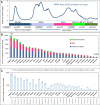
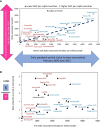
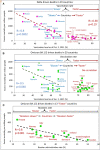
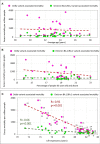
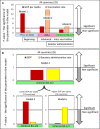
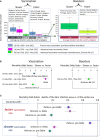
Update of
-
Comparison of Vaccination and Booster Rates and Their Impact on Excess Mortality During the COVID-19 Pandemic in European Countries.medRxiv [Preprint]. 2023 Mar 22:2023.03.21.23287548. doi: 10.1101/2023.03.21.23287548. medRxiv. 2023. Update in: Front Immunol. 2023 Jul 06;14:1151311. doi: 10.3389/fimmu.2023.1151311. PMID: 37090496 Free PMC article. Updated. Preprint.
Similar articles
-
Comparison of Vaccination and Booster Rates and Their Impact on Excess Mortality During the COVID-19 Pandemic in European Countries.medRxiv [Preprint]. 2023 Mar 22:2023.03.21.23287548. doi: 10.1101/2023.03.21.23287548. medRxiv. 2023. Update in: Front Immunol. 2023 Jul 06;14:1151311. doi: 10.3389/fimmu.2023.1151311. PMID: 37090496 Free PMC article. Updated. Preprint.
-
Risk and symptoms of COVID-19 in health professionals according to baseline immune status and booster vaccination during the Delta and Omicron waves in Switzerland-A multicentre cohort study.PLoS Med. 2022 Nov 7;19(11):e1004125. doi: 10.1371/journal.pmed.1004125. eCollection 2022 Nov. PLoS Med. 2022. PMID: 36342956 Free PMC article.
-
Disease severity and efficacy of homologous vaccination among patients infected with SARS-CoV-2 Delta or Omicron VOCs, compared to unvaccinated using main biomarkers.J Med Virol. 2022 Dec;94(12):5867-5876. doi: 10.1002/jmv.28098. Epub 2022 Sep 9. J Med Virol. 2022. PMID: 36029103 Free PMC article.
-
Role of previous infection with SARS-CoV-2 in protecting against omicron reinfections and severe complications of COVID-19 compared to pre-omicron variants: a systematic review.BMC Infect Dis. 2023 Jun 26;23(1):432. doi: 10.1186/s12879-023-08328-3. BMC Infect Dis. 2023. PMID: 37365490 Free PMC article.
-
The Vaccine Efficacy Against the SARS-CoV-2 Omicron: A Systemic Review and Meta-Analysis.Front Public Health. 2022 Jul 13;10:940956. doi: 10.3389/fpubh.2022.940956. eCollection 2022. Front Public Health. 2022. PMID: 35910897 Free PMC article.
Cited by
-
Importance of Vaccination Against COVID-19 in a Patient With End-Stage Rheumatoid Arthritis-Associated Interstitial Lung Disease (RA-ILD).Cureus. 2024 Jul 4;16(7):e63810. doi: 10.7759/cureus.63810. eCollection 2024 Jul. Cureus. 2024. PMID: 38974402 Free PMC article.
-
Excess Mortality and Containment Performance During the COVID-19 Pandemic: Evidence From 34 Countries.Am J Public Health. 2025 Sep;115(9):1518-1528. doi: 10.2105/AJPH.2025.308136. Am J Public Health. 2025. PMID: 40768708
-
Excess All-Cause Mortality by Age and Gender During the COVID-19 Pandemic in the Federation of Bosnia and Herzegovina, Bosnia and Herzegovina: 2020-2022.Influenza Other Respir Viruses. 2025 Mar;19(3):e70086. doi: 10.1111/irv.70086. Influenza Other Respir Viruses. 2025. PMID: 40010310 Free PMC article.
-
Cause-specific excess mortality in Denmark, Finland, Norway, and Sweden during the COVID-19 pandemic 2020-2022: a study using nationwide population data.Eur J Epidemiol. 2024 Sep;39(9):1037-1050. doi: 10.1007/s10654-024-01154-0. Epub 2024 Sep 16. Eur J Epidemiol. 2024. PMID: 39285102 Free PMC article.
-
Epidemiological outcomes and policy implementation in the Nordic countries during the COVID-19 pandemic.Arch Public Health. 2025 Feb 20;83(1):46. doi: 10.1186/s13690-025-01531-5. Arch Public Health. 2025. PMID: 39980066 Free PMC article.
References
-
- VaccineTracker . European Centre for disease prevention and control, COVID-19 vaccine tracker. Available at: https://vaccinetrackerecdceuropaeu/public/extensions/COVID-19/vaccine-tr... (Accessed November 24, 20222).
-
- Euronews . Slovakia Is second EU country to roll out russia’s Sputnik V COVID-19 vaccine (2021). Available at: https://www.euronews.com/my-europe/2021/06/07/slovakia-is-second-eu-coun....
-
- WHO . The sinovac-CoronaVac COVID-19 vaccine: what you need to know (2021). Available at: https://www.who.int/news-room/feature-stories/detail/the-sinovac-covid-1....
-
- Harder T, Kulper-Schiek W, Reda S, Treskova-Schwarzbach M, Koch J, Vygen-Bonnet S, et al. . Effectiveness of COVID-19 vaccines against SARS-CoV-2 infection with the delta (B.1.617.2) variant: second interim results of a living systematic review and meta-analysis, 1 January to 25 august 2021. Euro Surveill (2021) 26(41):2100920. doi: 10.2807/1560-7917.ES.2021.26.41.2100920 - DOI - PMC - PubMed
Publication types
MeSH terms
Supplementary concepts
LinkOut - more resources
Full Text Sources
Medical
Miscellaneous

